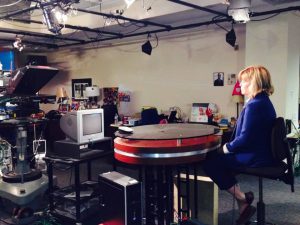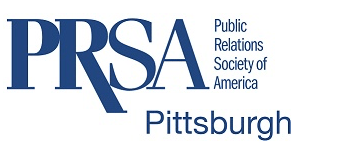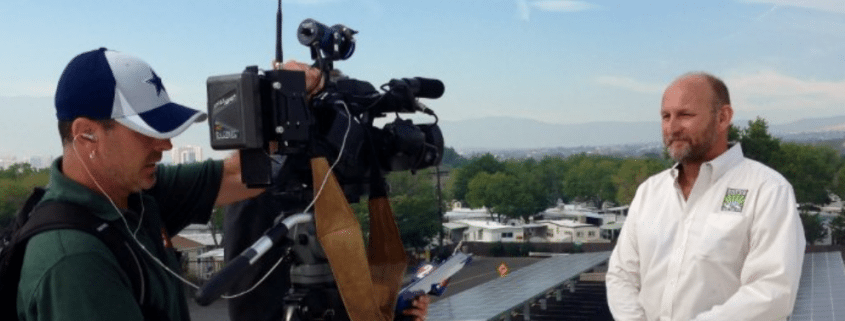5 Steps to Take Before Your CEO Goes on Camera
By Bridgette Borst Ombres
Note: Before you commit to any media interview, make sure you’ve researched the outlet and reporter and have decided it’s a good idea to take the interview in the first place. In a crisis, refer to your crisis communications plan for more detailed guidance around engaging with media.
Need a toolkit for getting your executive camera-ready? You’ve come to the right place – this post is jam-packed with tips, a “cheat sheet” you can download and additional resources that will ensure your CEO aces his or her next interview and lands killer soundbites.

Develop 3-4 key points
The soundbite has been shrinking for years so with limited time to get the main point(s) across in an interview, make every second count.
Honing in on a few key points will keep your spokesperson focused. If he or she shows up for an interview with a laundry list of things to say, this waters down the message and may come at the cost of getting attention around the most important things your brand wants to get in front of stakeholders.
Role play
Interview scenarios allow the CEO to apply communications skills/techniques in real time and provides the executive with an opportunity to practice the toughest questions.
If time allows, always record the role play takes and critique them afterwards.
Review bridging, bump-and-run, commenting without commenting and turn table techniques.
The CEO should build a verbal “bridge” from the reporter’s question to his or her answer (referring back to tip #1).
If a reporter fires off a tricky question, make sure the executive understands how to “bump” the question with a quick answer (yes or no) and “run” back to the 3-4 key points.
Commenting without commenting: In straightforward terms, the executive should explain why they can’t say more (i.e., the interviewee should stay in his or her lane and shouldn’t weigh in on an issue or subject that isn’t related to his or her duties).
It’s perfectly OK for the CEO to pose a question and quickly “turn the table” to answer it. For example, “The real question here is: ‘how are we responding to the cyberattack?’ We have a plan…”
As a former television reporter, I can tell you there’s no phrase more damning to a spokesperson than “no comment.” The reporter (and viewers) hear, “I’m guilty!”
Straight from Mr. Media Training himself, here’s a great read on how to answer tough questions.
Eliminate umm’s, like’s, uh’s and so’s.
Get rid of the verbal litter – it doesn’t add anything. In fact, it takes away substance, can become distracting and makes the interviewee appear less intelligent and polished. Sometimes it’s difficult for people to recognize this bad habit themselves initially, so the spokesperson must train his or her ear to listen for it. That’s why recording role plays is so helpful.
During media training clients, here’s a short exercise I use to help people become aware of using filler words:
Ask them to pick any object in the room (i.e., printer, television, filing cabinet, etc.) and talk about it for 30 seconds. Make note of how many times they use a verbal filler and point it out to them afterwards. This helps the person be more attune to when they’re using fillers since most people don’t even realize they do it.
Practice positive body language
Since most communication is nonverbal, be sure not to overlook this step. Positive body language isn’t limited to remembering to smile and not shifting your weight. It’s important to run through energy, tone, eye contact, gestures and posture with your CEO (another reason why recording role plays is critical in preparing for a media interview – so you and the CEO can see any negative body language issues that should be addressed).
Forgive the cliché, but practice makes (almost) perfect. Repetition helps to internalize the key message points and reduces the risk of going off-message or completely bombing the interview. No matter how seasoned the spokesperson, being prepared is the best recipe for a successful interview. If you can, try to pre-interview the reporter to get a better sense of the story’s focus and questions.
Whether you’re preparing for your next media interview or prepping the CEO (or another spokesperson) for one – click here to reference this quick “cheat sheet.”
Interested in learning more about how to land a successful media interview? Check out this blog post on what not to do – “Media Interviews: The 7 Deadly Sins.”
 Bridgette Borst Ombres is a former television news reporter turned PR and marketing professional with a decade of experience working in the communications field across agency, corporate and nonprofit sectors. Bridgette is the director of marketing and communications at a tech company in Pittsburgh and also consults for a variety of businesses.
Bridgette Borst Ombres is a former television news reporter turned PR and marketing professional with a decade of experience working in the communications field across agency, corporate and nonprofit sectors. Bridgette is the director of marketing and communications at a tech company in Pittsburgh and also consults for a variety of businesses.
She is a member of PRSA Pittsburgh, serves on the TEDxPittsburgh committee, the co-founder of Not Your Mama’s Book Club and volunteers as a mentor at both of her alma maters.





Leave a Reply
Want to join the discussion?Feel free to contribute!